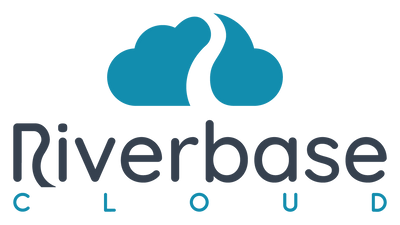What is SEO Content Creation?
SEO content creation is the process of developing website content specifically designed to rank well in search engines while providing value to human readers. It combines strategic keyword usage, search intent alignment, and quality writing to improve visibility and drive organic traffic.
For those looking to start creating SEO content right away:
- Research keywords relevant to your business and audience
- Analyze search intent behind those keywords
- Create valuable, comprehensive content that addresses user needs
- Optimize on-page elements (titles, headings, meta descriptions)
- Structure content for readability with proper formatting
- Include internal links to related content on your site
- Add multimedia (images, videos, infographics) where relevant
- Promote and distribute your content across channels
Creating content for search engines isn't just about stuffing keywords into a page. It's about crafting material that serves two masters: search algorithms and human readers. When done right, SEO content answers questions, solves problems, and guides users toward solutions—all while sending the right signals to search engines.
The most effective SEO content aligns with your business goals, speaks directly to your target audience, and demonstrates expertise in your field. According to research, businesses that regularly publish optimized content receive 350% more traffic than those that don't, making it one of the most powerful tools in your digital marketing arsenal.
I'm Gary Gilkison, founder of Riverbase Cloud, where I've helped countless businesses improve their online visibility through strategic SEO content creation that balances AI-powered optimization with human expertise to deliver measurable results.
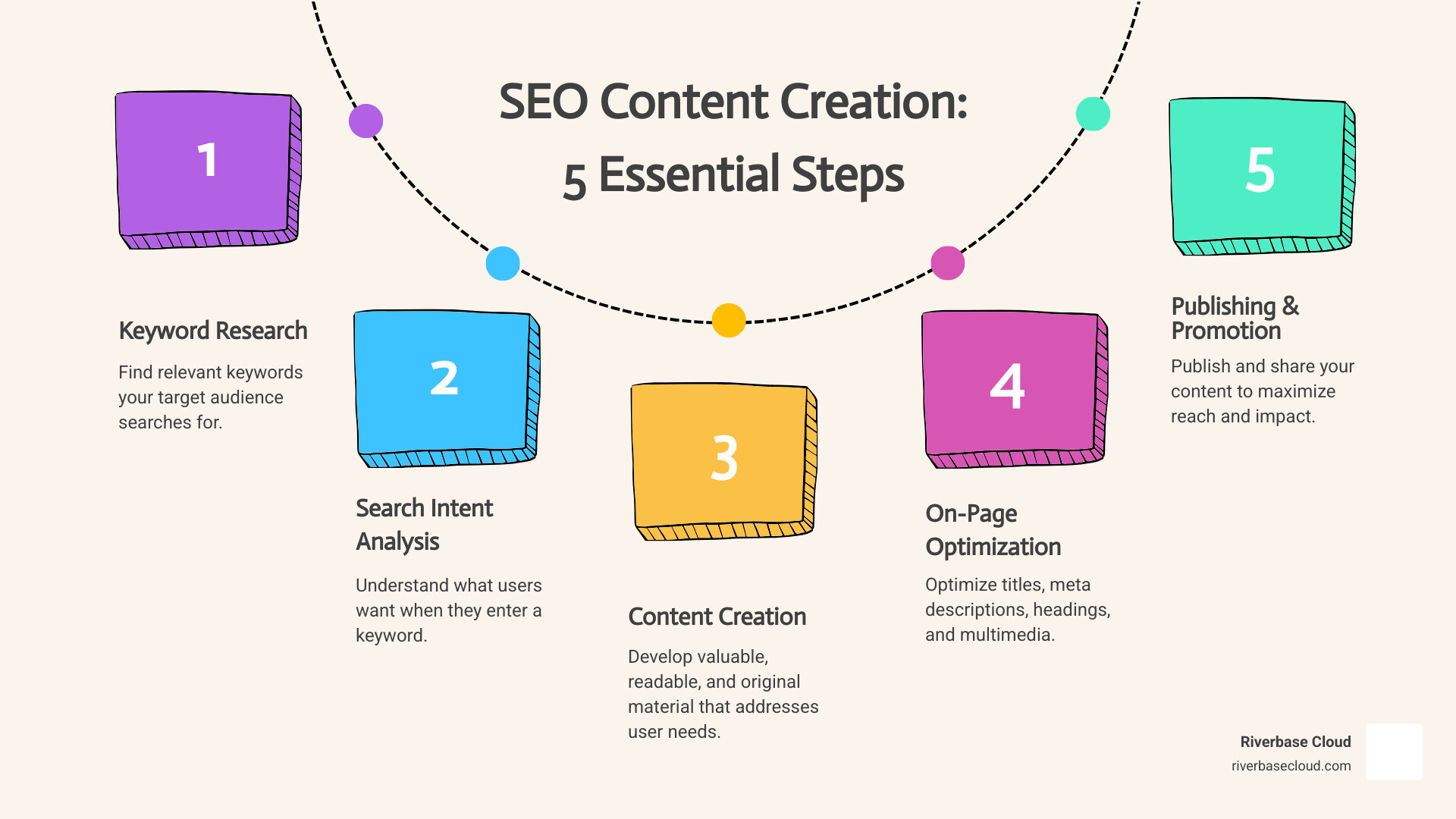
Handy SEO content creation terms:
- AI-driven content strategy
- SEO strategy development
- increase website traffic
Why SEO Content Still Rules in 2024
The digital marketing world never stops changing, but one thing remains rock-solid: SEO content creation is still king in 2024. And for good reason!
Despite all the algorithm updates and new technologies, content firmly holds its place as one of Google's top three ranking factors, alongside links and RankBrain (Google's clever AI system).
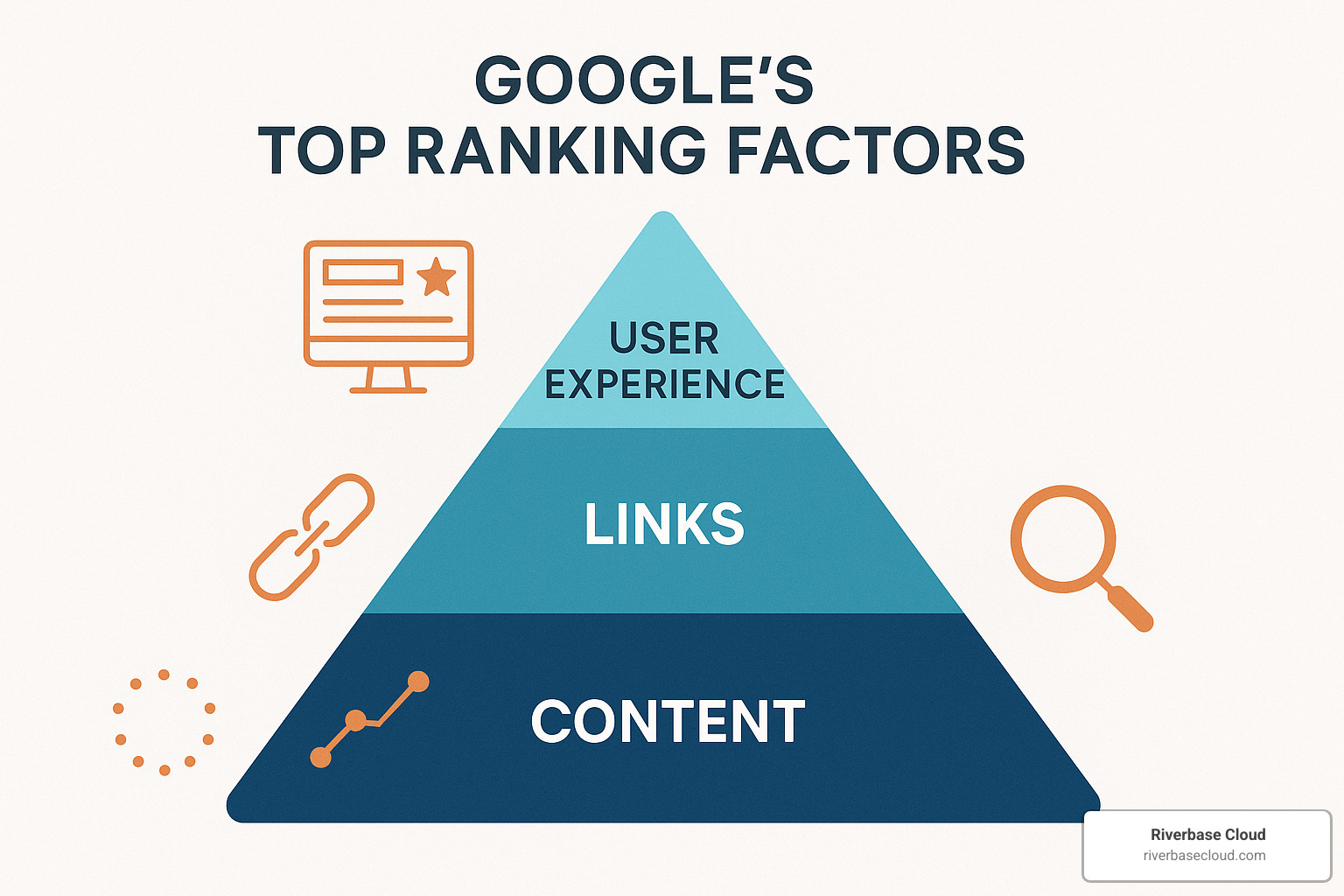
Google's E-E-A-T guidelines have become the gold standard for content evaluation. That's Experience, Expertise, Authoritativeness, and Trustworthiness. This is especially crucial for YMYL (Your Money or Your Life) topics where accuracy really matters.
The numbers tell an impressive story too. Businesses that consistently publish blog content see a whopping 350% more traffic than their silent competitors. The average word count for top-ranking content hovers around 1,447 words—not because longer is automatically better, but because comprehensive content tends to answer questions more thoroughly.
Topical authority has become increasingly important this year. Rather than creating random, disconnected content pieces, smart businesses build interconnected content clusters that demonstrate deep expertise in specific areas. This approach not only boosts your rankings but keeps visitors exploring your site longer.
At Riverbase Cloud, we've witnessed how businesses investing in quality SEO content creation consistently outshine their competition. One of our home services clients saw their organic form submissions jump by 131% after implementing our content strategy.
The truth is simple: when you create content that genuinely helps people while also speaking Google's language, everybody wins. And that's why SEO content creation will continue to rule in 2024 and beyond.
SEO Content Creation Process in 9 Steps
Creating effective SEO content isn't about throwing spaghetti at the wall to see what sticks—it's a thoughtful journey that blends art and science. At Riverbase Cloud, we've refined a 9-step SEO content creation process that consistently delivers results for our clients.

Building Your SEO Content Team
Before you write a single word, you need the right people in your corner. Your SEO Strategist orchestrates keyword strategy and keeps everyone aligned with search goals. The Content Writer brings your ideas to life with engaging prose. Your Editor polishes everything to a shine. The Designer adds visual magic that captures attention. And your Subject Matter Expert provides the deep knowledge that gives your content credibility.
For many small businesses, one person might wear multiple hats—and that's perfectly fine! The secret sauce? Involving SEO experts from day one—not just calling them in at the last minute to sprinkle keywords on already-written content.
Step 1: Research & Keyword Finding
Every great piece of SEO content creation starts with understanding what your audience is searching for. We begin by digging for keyword gold:
We start with seed keywords related to your business, then expand using tools like Ahrefs, Semrush, or BuzzSumo. We analyze search volume, competition levels, and organize everything by search intent.
Long-tail keywords are often where the magic happens. These longer, more specific phrases might have lower search volume, but they usually signal higher intent and face less competition.
When evaluating keywords, we look beyond raw numbers to assess the traffic potential, business value, ranking difficulty, and search intent alignment.
Step 2: Mapping Search Intent & Site Structure
Understanding the "why" behind a search query transforms good SEO content creation into great content that truly connects. We analyze search intent across four main categories: informational, navigational, commercial, and transactional.
By studying what currently ranks for your target keywords, we can decode what Google considers most relevant for each query.
Equally important is how your content fits within your website's overall architecture. We recommend organizing content in a pyramid structure:
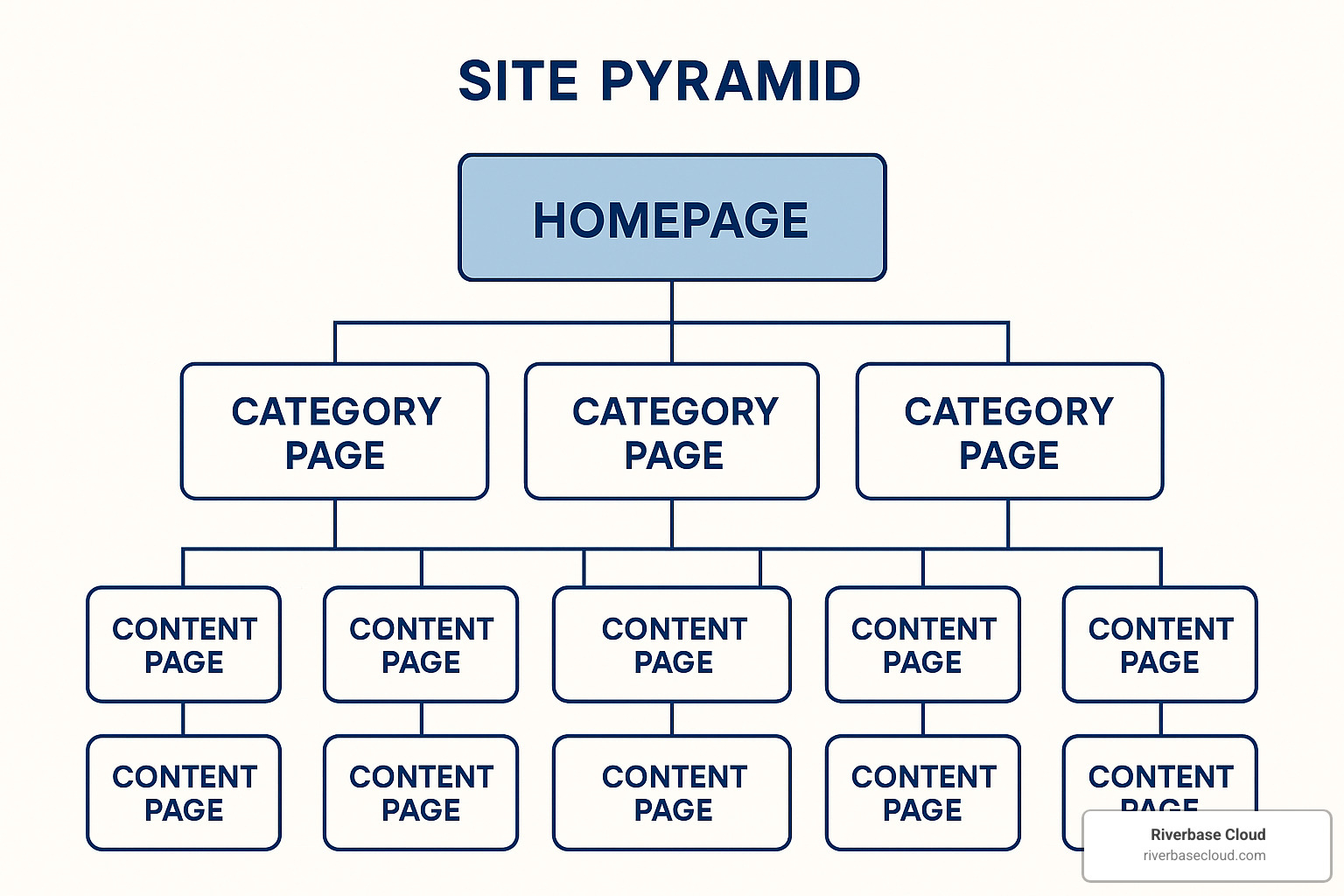
Your homepage and main category pages sit at the top, targeting broader keywords. The middle level consists of subcategory pages that group related topics. At the bottom, individual content pages target specific long-tail keywords.
Step 3: Drafting People-First, Search-Optimized Copy
Now comes the fun part—creating content that serves both human readers and search engine algorithms. Our approach puts people first while keeping search engines in mind.
Readability is non-negotiable. Research from the Public Relations Society of America shows that shorter sentences dramatically improve understanding. We aim for sentences averaging 14-20 words and use tools like Hemingway Editor to keep content clear and accessible.
Originality matters more than ever. With millions of articles published daily, your content needs to offer something fresh. Google's Helpful Content System specifically rewards content that demonstrates real experience and expertise.
We believe in being comprehensive without being exhausting. Top-ranking content typically covers topics thoroughly, answering not just the main question but related questions readers might have.
Engagement keeps readers on the page. We incorporate storytelling, relatable examples, and varied content formats to maintain interest. Scientific research on readability confirms that breaking up text with subheadings, bullet points, and images improves both comprehension and retention.
Finally, we weave in E-E-A-T signals that demonstrate Experience, Expertise, Authoritativeness, and Trustworthiness. At Riverbase Cloud, our Managed-AI CONTENT approach gives you the best of both worlds: AI-powered efficiency with human creativity and judgment. More info about Content Creation 101
Step 4: On-Page Optimization Essentials
On-page optimization is where we ensure search engines understand what your content is about. Key elements include:
Your title tag needs to grab attention while clearly conveying what the content offers. We include your primary keyword near the beginning, keep it under 60 characters, and make it compelling enough to encourage clicks.
Meta descriptions serve as your 150-160 character advertisement in search results. A well-crafted meta description with natural keyword usage and action-oriented language can significantly improve click-through rates.
Heading structure organizes your content for both readers and search engines. Your H1 should include your primary keyword, with H2s breaking content into main sections and H3s/H4s for subsections.
Image optimization includes descriptive file names, alt text that explains the image while naturally including keywords, and proper compression for faster loading.
Schema markup provides explicit signals to search engines about your content type and purpose.
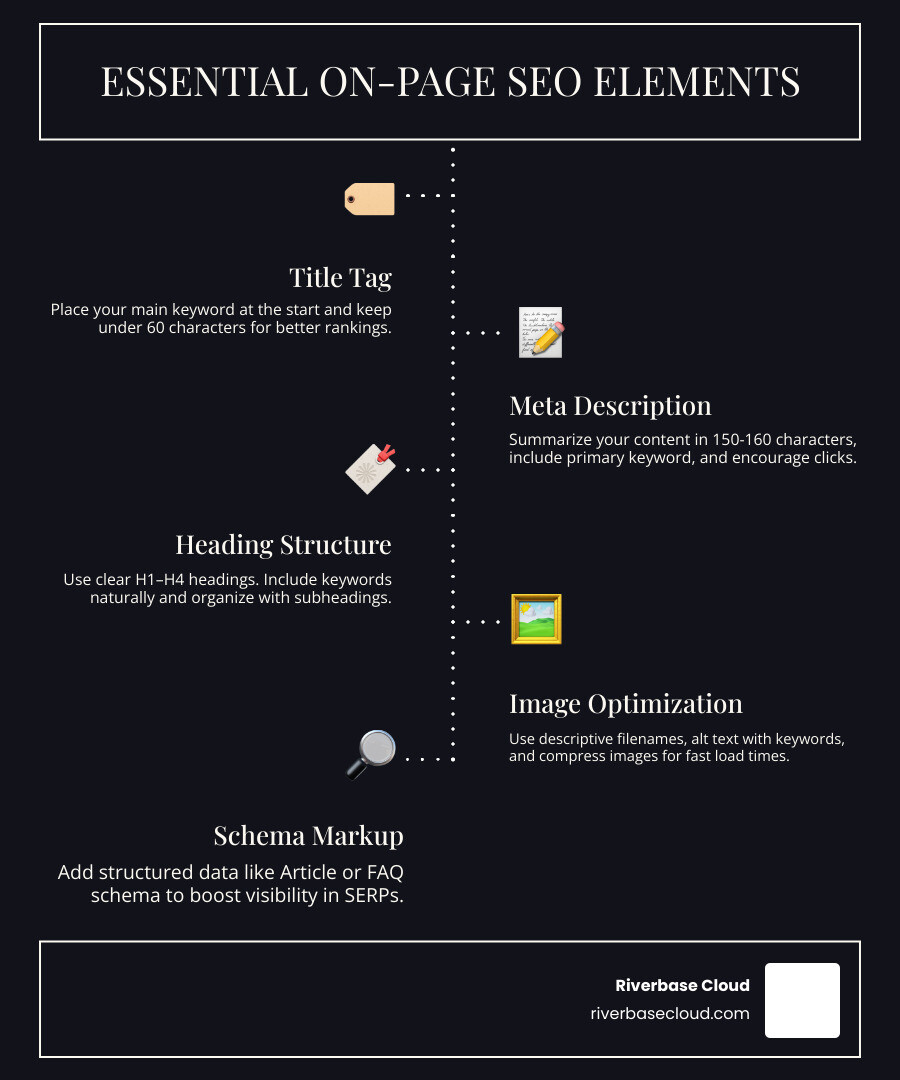
Step 5: SEO Content Creation Review & Approval
Quality control separates good content from great content. Our review process includes:
- Content quality check: Examines accuracy, search intent alignment, topic coverage, originality, and readability
- SEO technical review: Focuses on keyword usage, heading structure, links, image optimization, and schema markup
- Editorial review: Addresses grammar, spelling, brand voice consistency, clarity, and flow
- Accessibility check: Ensures content is usable by everyone with proper alt text, logical heading hierarchy, and descriptive link text
Step 6: Publishing & Distribution
Even the most brilliant content needs a push to reach its audience. We consider strategic timing based on your audience's habits and ensure proper indexing through Google Search Console.
Content distribution extends across multiple channels: social media platforms, email newsletters, industry forums, content syndication sites, and sometimes paid promotion.
Don't forget internal promotion—featuring important content on your homepage, adding related content recommendations, and internal linking from existing pages.
Step 7: Measurement & KPIs
You can't improve what you don't measure. We focus on four key areas:
- Traffic metrics: Organic sessions, page views, time on page, bounce rate
- Engagement metrics: Scroll depth, social shares, comments, internal link CTRs
- Conversion metrics: Lead form submissions, email sign-ups, product purchases
- SEO performance metrics: Keyword rankings, featured snippets, backlinks acquired
The key is connecting content performance to business goals. Rankings and traffic are important stepping stones, but the ultimate measure is generating leads, sales, or other valuable actions.
Step 8: Updating & Refining Existing Assets
SEO content creation isn't a "plant it and forget it" activity. Content requires regular maintenance to continue thriving.
Regular content audits help identify underperforming pages with declining traffic, outdated information, poor engagement metrics, or keyword cannibalization issues.
Our content refresh strategies include updating statistics, expanding coverage of subtopics, improving readability, enhancing visual elements, and updating internal links.
Sometimes, content consolidation makes more sense than updates. This might involve merging similar content pieces, implementing redirects, or creating comprehensive cornerstone content from related articles. More info about Mastering Website Content Creation
Step 9: Link Building & Off-Page Signals
While on-page factors are within your control, off-page signals like backlinks significantly impact your search visibility.
Strategic outreach involves identifying industry influencers and publications, developing personalized pitch templates, and tracking relationship development over time.
Creating link-worthy content is fundamental to successful outreach. Original research, comprehensive guides, expert interviews, and interactive tools naturally attract links because they provide genuine value.
Broken link building offers a win-win opportunity: find broken links on authoritative sites, create replacement content, and reach out with helpful suggestions.
According to the Nielsen Trust Study, third-party endorsements significantly increase credibility. Backlinks function as digital endorsements, signaling to Google that others find your content valuable and trustworthy.
Advanced Techniques to Boost SEO Content Creation
As SEO content creation continues to evolve, advanced techniques can give you a competitive edge. Here are cutting-edge strategies we implement at Riverbase Cloud:

Semantic SEO
Gone are the days of keyword stuffing. Today's semantic SEO focuses on the meaning behind your content rather than exact keyword matches.
We build comprehensive topic coverage through topic modeling – identifying related concepts that should naturally appear in well-rounded content. We pay special attention to entity optimization, making sure your content clearly communicates important people, places, things, and concepts that Google recognizes.
Our writers craft content with natural language processing (NLP) principles in mind, writing in ways that align with how search engines actually understand language.
Schema Markup Implementation
Think of schema markup as your content's translator for search engines. This structured data helps Google understand exactly what your content means – not just what it says.
We strategically implement schema types custom to your specific content: Article schema for blog posts, HowTo schema for step-by-step guides, FAQ schema for question-based content, Product schema for e-commerce pages, and LocalBusiness schema for location-specific businesses.
When properly implemented, schema markup can transform your search listings into eye-catching rich results – including featured snippets, knowledge panels, and other improved listings that stand out from the competition.
Featured Snippet Optimization
Winning that coveted "position zero" above traditional search results can capture significant traffic. Our approach to featured snippets is methodical and proven.
We start by identifying snippet opportunities through targeted keyword research. Then we structure your content to directly answer questions in the most snippet-friendly format. Clear formatting – whether through concise paragraphs, numbered lists, or simple tables – makes it easy for Google to extract and feature your content.
One client saw a 37% increase in organic traffic after we restructured their content with clear question-based headings and concise answers.
Voice Search Optimization
"Hey Siri, how do I optimize for voice search?" As smart speakers and voice assistants become household staples, optimizing for spoken queries is increasingly important.
Voice search requires a different approach than traditional SEO. We focus on conversational, question-based keywords that mirror how people actually talk. Our content provides direct, concise answers to common questions while incorporating natural language patterns that match spoken queries.
For local businesses, we emphasize "near me" queries and location-specific information that voice searchers commonly request.
Accessibility Improvements
Creating accessible content isn't just the right thing to do – it's smart SEO. When your content works better for people with disabilities, it generally works better for everyone.
We implement a proper heading hierarchy that makes content navigable for screen readers. Every image gets descriptive alt text that serves both users with visual impairments and search engines. For multimedia content, we provide transcripts that make information accessible to everyone. More info about AI in content strategy
Integrating Managed-AI Workflows for SEO Content Creation
At Riverbase Cloud, we've developed a Managed-AI approach that gives you the best of both worlds: AI efficiency with human creativity and judgment.
Our SEO content creation workflow starts with AI-Powered Research that quickly identifies keywords, analyzes competitors, and gathers topic insights. Then we use AI-Assisted Drafting to create initial content frameworks based on proven structures.
Here's where we differ from fully automated solutions: real human experts step in for Human Expert Editing, refining and improving the AI-generated content with their subject matter expertise, creativity, and understanding of your brand voice. We then leverage AI Optimization Tools to check readability, SEO factors, and engagement potential before a final Human Strategic Oversight review ensures everything aligns with your business goals.
This hybrid approach delivers content that's both efficient to produce and genuinely valuable to readers. Unlike purely AI-generated content (which Google can detect and may penalize), our Managed-AI CONTENT maintains the human touch that's essential for creating truly engaging material.
Frequently Asked Questions about SEO Content Creation
What is the difference between SEO content and regular content?
When clients ask me this question, I like to use a simple analogy: regular content is like building a beautiful store in the middle of nowhere, while SEO content is building that same beautiful store on a busy street with clear signage.
SEO content creation goes beyond just writing good material by strategically incorporating elements that help search engines understand, index, and rank your content. This includes researching keywords that your audience is actively searching for, structuring content to match specific search intent, and implementing technical elements like optimized metadata and internal links.
The good news? The line between "regular" and "SEO" content has become increasingly blurred. Google's algorithms have evolved to prioritize genuine quality and user experience. Content that truly helps readers, demonstrates expertise, and engages visitors naturally tends to perform better in search results.
How often should I update existing SEO content?
Content isn't a "set it and forget it" asset—it needs regular care to maintain and improve performance. But how often should you update? It depends on several factors.
For rapidly changing industries like technology or healthcare, you might need quarterly updates to remain accurate. For more stable topics, semi-annual refreshes might suffice. The competitive landscape matters too—highly contested keywords often require more frequent attention to maintain rankings.
Pay close attention to your analytics. When a previously high-performing page starts showing declining traffic or engagement, that's a clear signal it's time for a refresh.
Here's a practical approach I recommend to clients:
- Review high-traffic, business-critical pages quarterly
- Conduct a comprehensive content audit annually
- Update news or trend-based content as developments occur
- Refresh product pages whenever features or offerings change
Which metrics show SEO content success?
Measuring the success of your SEO content creation efforts requires looking beyond simple page views. Think of it as assessing the health of your content from multiple angles.
First, examine search performance metrics. Are you ranking for your target keywords? Is your organic traffic growing month over month? Has your click-through rate from search results improved? These indicators show whether your content is gaining visibility and attracting clicks.
Next, look at how users engage with your content once they arrive. Are they spending time reading (average time on page)? Do they explore other pages on your site (pages per session)? Are they scrolling to the bottom of your content? These engagement metrics reveal whether your content delivers on the promise made in search results.
Most importantly, track how content contributes to business goals. For some pages, this means direct conversions like form submissions or purchases. For others, it might be email sign-ups or phone calls.
Don't overlook authority signals either. Backlinks from reputable sites, social shares, and brand mentions all indicate your content is valuable enough for others to reference—a powerful indicator of quality that also strengthens your SEO foundation.
Conclusion
Creating effective SEO content isn't just a marketing tactic—it's a long-term investment that continues to pay dividends long after you hit publish. Throughout this guide, we've walked through our nine-step process that balances the technical needs of search engines with the very human needs of your readers.
What makes SEO content creation so powerful is its staying power. Unlike paid ads that disappear the moment you stop funding them, quality content works for your business around the clock, often becoming more valuable over time as it gains authority, backlinks, and trust from your audience.
I've seen how businesses transform their digital presence by committing to quality over quick fixes. The companies that win at SEO aren't necessarily the ones with the biggest budgets—they're the ones who consistently create content that genuinely helps their audience solve problems.
As search algorithms continue to evolve, they're getting better at recognizing true expertise and authentic value. This trend favors businesses that demonstrate real knowledge and trustworthiness in their content. In other words, the future of SEO rewards being genuinely helpful, not just technically optimized.
At Riverbase Cloud, our Managed-AI CONTENT approach gives you the best of both worlds. We harness the efficiency and data-processing power of AI while ensuring every piece of content receives the human touch that makes it engaging, accurate, and aligned with your brand voice. This balanced approach delivers content that not only ranks well but actually connects with your target audience—driving not just traffic but meaningful business results.
Whether you're just beginning your content journey or looking to improve an existing strategy, navigating the complexities of SEO content creation doesn't have to be overwhelming. With the right approach and support, you can build a content engine that sustainably grows your business through search.
Ready to lift your content strategy? Learn more about our content SEO solutions and find how our Managed-AI approach can transform your online visibility without the stress and complexity of doing it all yourself.
